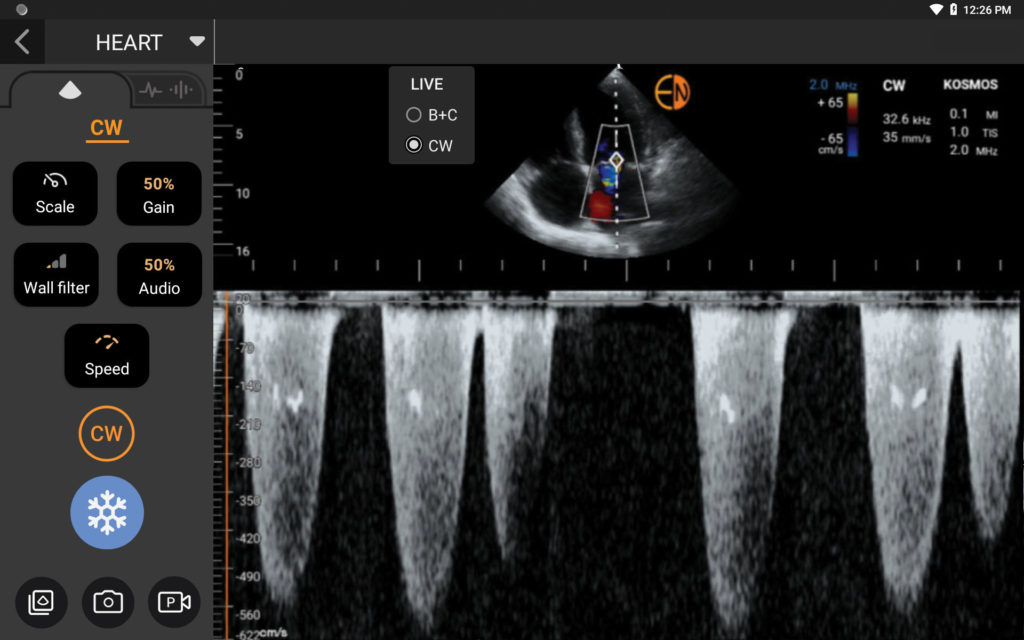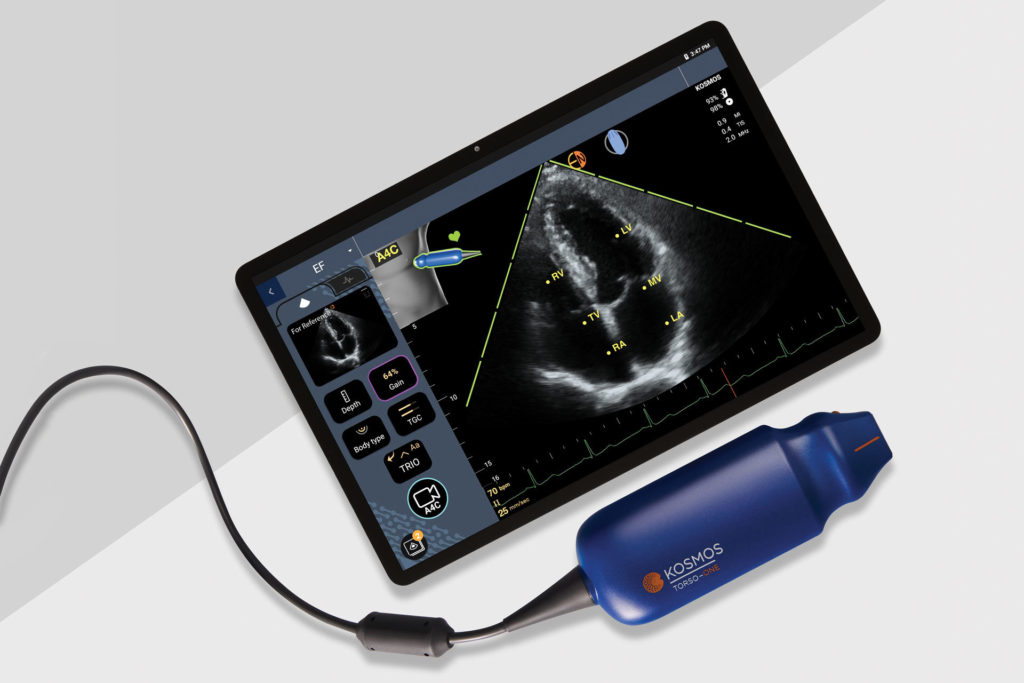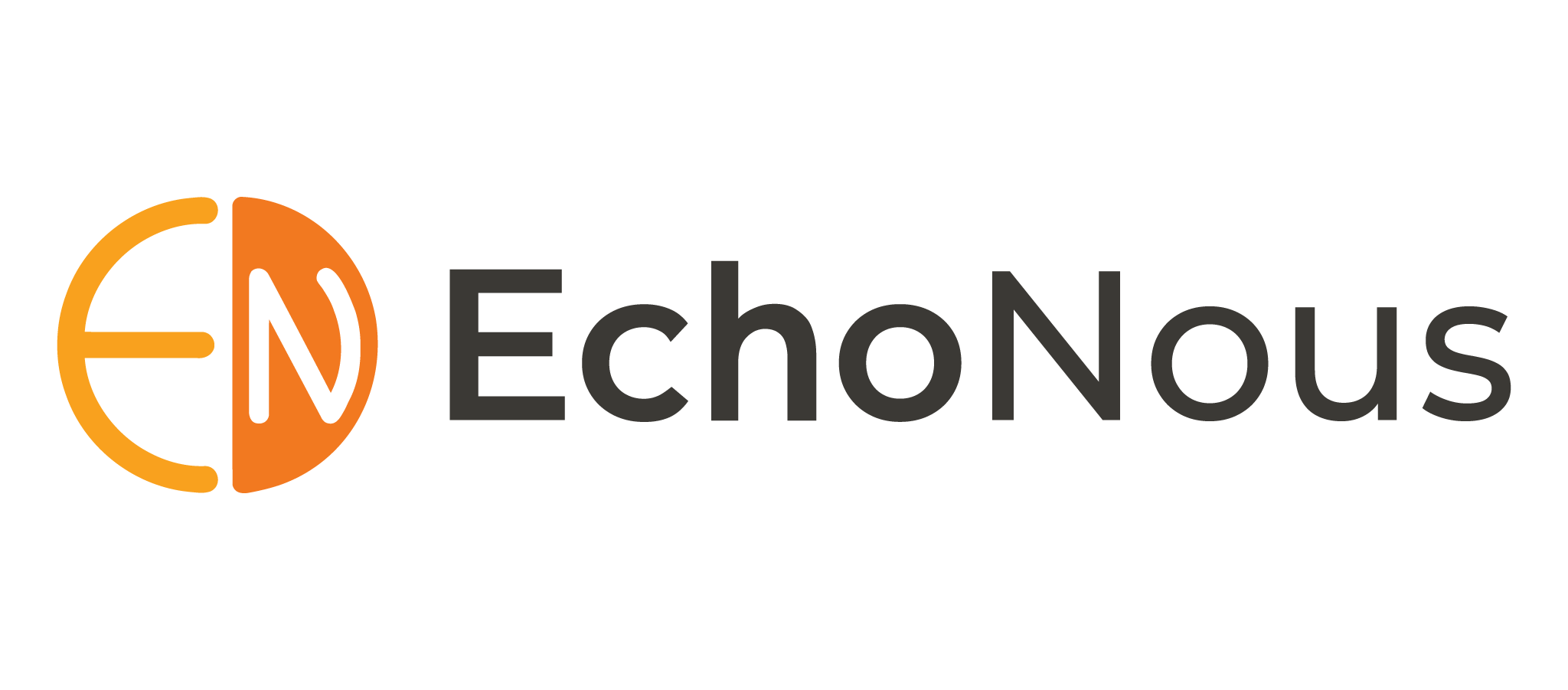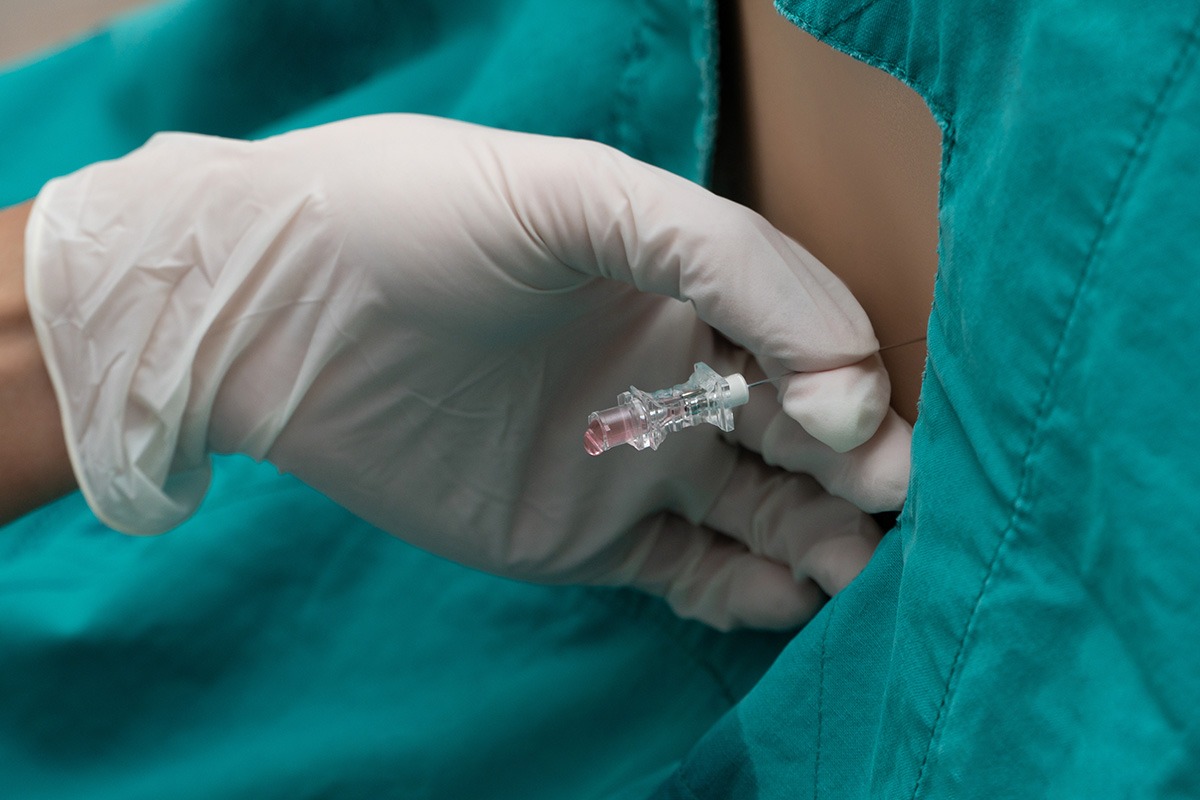Clinical Benchmarking for the Kosmos Platform
Clinical benchmarking experience with the Kosmos platform, a novel AI-based handheld ultrasound system, after scanning 1200 patients in a tertiary care environment, including 600 cardiology consults.
Background
Over the last decade, there has been increasing interest in point-of-care ultrasound (POCUS) as an aid to traditional patient examination techniques. In many instances, history and clinical examination alone are unable to provide all the necessary information for optimal patient management during a cardiac assessment. Improved portability of the equipment has enabled cardiac ultrasound imaging to be performed at the bedside, offering cardiologists immediate answers to clinical questions. Kosmos is a handheld ultrasound system that utilizes ultra-miniaturized technology and advanced artificial intelligence (AI), enabling physicians to provide point-of-care services to patients in hospitals, clinics, home care, and ambulatory settings.
The goal of this study is to assess if a high-quality ultra-portable system can be used as an adjunct to higher cost cart-based systems, to answer specific clinical questions at the bedside, speed up patient management, and improve workflow.
Methods
The Kosmos has been routinely used in our hospital from April 2020 through to the time of this publication, March 2021, specifically in the following settings:
- Ward rounds and Coronary Care Unit (CCU)
- Cardiology Consultations
- Emergency Medicine Department (ED)
Note: During this period, the COVID-19 pandemic occurred. This posed logistical challenges in the care of patients, highlighting the need for accurate, easily disinfected equipment that could be used at the patients’ bedside. Kosmos meets these criteria and has been used throughout the period.
Study
In the period from April 2020 to February 2021, over 1200 patients were scanned with Kosmos.
During this evaluation period, several software upgrades were implemented to enhance 2D image quality and Color Doppler performance. This led to the latest image quality being clinically comparable to high-end, cart-based cardiac systems.
More recently, 50 patients were evaluated on the Kosmos system that included the newly released Pulsed-Wave (PW) and Continuous-Wave (CW) Doppler, which was compared to high-cost, cart-based cardiac systems. Both the PW and CW Doppler enable a comprehensive assessment of heart valve disease, not previously available on hand-carried systems due to the increased power levels and high processing requirements.
In addition, 100 patients were tested to evaluate the AI-based automated left ventricle ejection fraction (EF) values, by comparing it to the EF measured with high-end, cart-based cardiac systems.

Torso-One with Kosmos Bridge
Results
Ward Rounds, Coronary Care Unit (CCU)
Kosmos demonstrated its convenience and usability on ward rounds, where it was used daily to answer specific clinical questions and make clinically optimal decisions for efficient patient management.
We scanned 300 patients in this setting. The use of Kosmos obviated the need for referral (to the echo lab) in approximately 270 patients (90%). This results in many benefits, saving time, costs and resources, allowing the large cart-based systems to be put to more efficient use.
In the CCU where large scale, cart-based machines are readily available, Kosmos was frequently the preferred system of choice, due to its portability, excellent clinical performance, and fast boot-up time (13 seconds). In the CCU, every second counts, so speed and efficiency are essential. In one memorable example during the COVID-19 pandemic, there was a case of a critically ill patient in the CCU. Kosmos enabled the diagnosis of a life-threatening condition (myocardial wall rupture after myocardial infarction) on a 70-year-old obese (body mass index – BMI ~35 kg/m2) patient, resulting in immediate, lifesaving surgical treatment of the patient. The cart-based echo machine was unavailable at the time, as it was being used for scanning COVID-19 patients in isolation. This case has already been published in the literature (doi: 10.1002/ccr3.35461).
Cardiology Consultations
Kosmos has demonstrated its usefulness for cardiology consultations, given its small size and weight. 600 consultations were performed, which successfully gave the clinical assessment at the patient bedside providing all the necessary diagnostic information in 560 patients. There were a few cases where technical limitations, limited a comprehensive exam, e.g. valvular heart disease patients, where CW Doppler was necessary (this was not available at the time on Kosmos), or patients with challenging acoustic windows.
In our study, using Kosmos reduced more than 90% of patient referrals for complete echocardiographic examinations, in the already over-burdened echo labs, a very important marker of value in these times. The result is more timely patient care, combined with significant and obvious cost savings.
Emergency Medicine (E-Med)
In the E-Med setting, accurate decisions are required in a timely fashion, sometimes in crowded spaces; (e.g. medical or traumatic arrests). Cart-based systems are available in the E-Med department, however the small size and portability of Kosmos, combined with its easy cleaning and disinfection, have made Kosmos especially valuable for physicians, particularly in the assessment of isolated patients (COVID-19).
104 patients were scanned with Kosmos in the E-Med setting. Image quality was diagnostic grade in almost all cases, with rare exceptions, where patients were unable to co-operate or had challenging acoustic windows. Critical diagnoses, such as aorta dissection, pericardial effusion, cardiac tamponade and dilated right heart chambers due to massive pulmonary embolism were achieved, and in some cases, were followed by life saving interventional procedures.
Use of Kosmos in the COVID- 19 Pandemic
During the peak of the COVID-19 pandemic, more than 200 patients with COVID-19 pneumonia were hospitalized for three months. Unique challenges, such as isolation of the patients and difficulties in transfer of the patients for testing, created the need for widespread use of small portable, easy to disinfect devices for accurate and timely clinical decision making.
Kosmos was the device of choice used for this purpose in our hospital (Papageorgiou Hospital, Thessaloniki, Greece). 312 COVID-19 patients were scanned during the three-month period. In 95% of cases, immediate answers to critical clinical questions were achieved.
The ability to acquire superior quality images of the heart, lungs and abdomen using one (phased array) probe offers clear advantages. The continued use of the device during this window represents a positive experience with users.
Comparison of Kosmos AI- based automated ejection fraction (EF) with standard high-end cart-based echo systems EF calculation
A convenience sample of 100 consecutive patients have been scanned with Kosmos. Mean age 57±15 y, range: 15-95 y; mean BMI: 28±4 kg/m2, range: 19-46 kg/m2; male: 61%. The Kosmos AI-based automated EF was used to assess left ventricular systolic function and the results were compared with the EF measured using the gold standard biplane Simpson’s method, on a cart-based, high-end cardiac system.

Image 1: EF calculation by Simpson’s bi-plane method
There was a strong, statistically significant correlation of 0.87 (p<0.0001) between the two EF measurements. Furthermore, the bias between the two EF measurements was 1.42%, and the root mean square deviation (RMSD) 7.51%. The bias is defined as the average difference between the high-end, cart-based cardiac device EF and the Kosmos AI-based EF, and the RMSD as the square root of the average of the squared differences between the two EF measurements. The RMSD is a mathematically robust metric for estimating measurement accuracy, and it is well accepted by the FDA, as seen in recent FDA clearance summaries2,3. Both the correlation and the RMSD of the Kosmos AI-based EF are close to those found in similar EF studies cleared by the FDA.
More specifically, Caption Health had previously reported an RMSD of 8.29%2 vs. the RMSD of 7.51% we report in this study, and Dia Analysis has previously reported a correlation of 0.883 vs. the 0.87 we report in this study.
It is important to note that Kosmos AI automated EF (image 1) can be obtained by the user in less than 15-20 seconds (including acquiring images) and that using cart-based echo machines requires the equivalent time for calculating EF in the range of 2-3 mins.
Based on the data and findings reported in this study, we conclude that Kosmos, with its AI-based EF capability, can offer fast and accurate systolic heart function assessment in real-world clinical settings.
Comparison of Kosmos PW & CW Doppler results with high-end, cart-based systems (preliminary results)
A convenience sample of 50 consecutive patients were scanned and our study compared the peak PW and CW measured velocities with Kosmos to the velocities obtained on the same patients when scanned with a cart-based, high-end echo machine. In both cases velocities were determined manually by the expert physician.
Kosmos is the first handheld device that incorporates CW Doppler functionality and enables full assessment of heart valve disease (image 2).

Image 2: CW Doppler in a patient with a mitral valve regurgitation
We found a strong, statistically significant correlation of 0.98 (p<0.0001) between CW peak velocities measured with the high-end, cart-based echocardiography system and Kosmos.
We found Kosmos slightly underestimating CW velocities on average by 0.15 m/sec, which is clinically non-significant, as shown by the computed bias of 0.15 m/sec between the high-end cart-based system and Kosmos CW peak velocity manual measurements. The RMSD between the two measurements was 0.26 m/sec, which is also not a clinically significant difference. The range of the CW velocities measured on the patients was from 1.1 m/sec to 5 m/sec.
Based on the data found in this study, we conclude that the Kosmos’ spectral PW/CW Doppler is highly sensitive to the flow dynamics and is of diagnostic quality.

Conclusions
- Utilization of Kosmos in everyday cardiology practice facilitates diagnosis and management of patients in various settings (ward rounds, CCU, consultations, and E-Med), and has the potential of enhancing patient care at a very low marginal cost.
- Advantages of Kosmos are its small size and portability combined with exceptional ultrasound fundamentals of image quality and Doppler functionality, which results in savings of cost, time and resources.
- In the COVID-19 era, Kosmos has been an extremely effective diagnostic imaging tool for clinical decision making.
- Spectral CW/PW Doppler is of diagnostic quality and will further increase the diagnostic value of Kosmos.
- AI-based automated EF application on Kosmos is a fast and reliable clinical tool for assessment of left ventricular systolic function.
References
1. Sachpekidis V, Adamopoulos C, Datsios A, Mosialos L, Stamatiadis N, Gogos C, Poulianitis V, Galanos O, Stratilati S, Styliadis I, Nihoyannopoulos P. A tricky case of cardiogenic shock: Diagnostic challenges in the COVID-19 era. Clin Case Rep. 2021;9:420-424
2. Caption Health FDA 510(k) Summary for AI EF Clearance. https://www.accessdata.fda.gov/cdrh_docs/pdf17/K173780.pdf
3. Dia Analysis FDA 510(k) Summary for Automated EF Clearance: https://www.accessdata.fda.gov…
† Cardiology Consultant. Department of Cardiology, Papageorgiou Hospital, Thessaloniki, Greece
‡ Private Practice Physician, Thessaloniki, Greece
§ Professor of Cardiology. Department of Cardiovascular Sciences, Hammersmith Hospital, Imperial College London, London, UK




